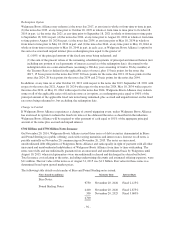Walgreens 2015 Annual Report Download - page 104
Download and view the complete annual report
Please find page 104 of the 2015 Walgreens annual report below. You can navigate through the pages in the report by either clicking on the pages listed below, or by using the keyword search tool below to find specific information within the annual report.
(1) Restricted cash consists of deposits restricted under agency agreements and cash restricted by law and other
obligations.
(2) Money market funds are valued at the closing price reported by the fund sponsor.
(3) Fair values of quoted investments are based on current bid prices as of the balance sheet dates. See Note 7,
Available-for-Sale Investments for additional disclosures.
(4) The fair value of interest rate swaps is calculated by discounting the estimated cash flows received and paid
based on the applicable observable yield curves. See Note 11, Financial Instruments for additional
disclosures.
(5) The fair value of forward currency contracts is estimated by discounting the difference between the
contractual forward price and the current available forward price for the residual maturity of the contract
using observable market rates.
(6) Warrants were valued using a Monte Carlo simulation. Key assumptions used in the valuation include risk-
free interest rates using constant maturity treasury rates; the expected dividend yield for
AmerisourceBergen’s common stock; AmerisourceBergen’s common stock price at the valuation date;
AmerisourceBergen’s equity volatility; the number of shares of AmerisourceBergen’s common stock
outstanding; the number of AmerisourceBergen employee stock options and the exercise price; and the
details specific to the warrants.
(7) Forward interest rate swaps were valued using three-month LIBOR rates. See Note 11, Financial
Instruments for additional disclosures.
There were no transfers between levels in fiscal 2015 or 2014.
The Company reports its debt instruments under the guidance of ASC Topic 825, Financial Instruments, which
requires disclosure of the fair value of the Company’s debt in the footnotes to the consolidated financial
statements. Unless otherwise noted, the fair value for all notes was determined based upon quoted market prices
and therefore categorized as Level 1. See Note 10, Short-Term Borrowings and Long-Term Debt for further
details. The carrying values of accounts receivable and trade accounts payable approximated their respective fair
values due to their short-term nature.
13. Commitments and Contingencies
The Company is involved in legal proceedings and is subject to investigations, inspections, audits, inquiries and
similar actions by governmental authorities, arising in the normal course of the Company’s business, including
the matters described below. Legal proceedings, in general, and securities and class action litigation, in
particular, can be expensive and disruptive. Some of these suits may purport or may be determined to be class
actions and/or involve parties seeking large and/or indeterminate amounts, including punitive or exemplary
damages, and may remain unresolved for several years. From time to time, the Company is also involved in legal
proceedings as a plaintiff involving antitrust, tax, contract, intellectual property and other matters. Gain
contingencies, if any, are recognized when they are realized. The results of legal proceedings are often uncertain
and difficult to predict, and the costs incurred in litigation can be substantial, regardless of the outcome. The
Company believes that its defenses and assertions in pending legal proceedings have merit, and does not believe
that any of these pending matters, after consideration of applicable reserves and rights to indemnification, will
have a material adverse effect on the Company’s consolidated financial position. However, substantial
unanticipated verdicts, fines and rulings do sometimes occur. As a result, the Company could from time to time
incur judgments, enter into settlements or revise its expectations regarding the outcome of certain matters, and
such developments could have a material adverse effect on its results of operations in the period in which the
amounts are accrued and/or its cash flows in the period in which the amounts are paid.
On a quarterly basis, the Company assesses its liabilities and contingencies for outstanding legal proceedings and
reserves are established on a case-by-case basis for those legal claims for which management concludes that it is
probable that a loss will be incurred and that the amount of such loss can be reasonably estimated. Substantially
- 100 -
























